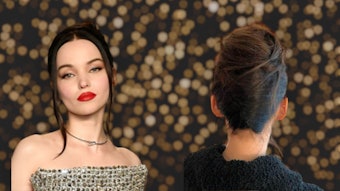 In the beginning of the year, I shared my mission to speak and work differently to demonstrate how stylists can deliver more value to clients in today’s world. Changing language to start conversations that open the door to discovering new creative approaches in cutting and finishing globally influenced shapes. Using condensed and precision cutting to create modern details, beginning cuts in unfamiliar sections of the head and working with sectioning patterns to cut and finish hair effortlessly and quickly. The goal is to share techniques and patterns that everyone can adopt a piece of – either by incorporating new techniques into familiar cuts to accelerate cutting time and improve the end result, or to create fresh looks that can be cut efficiently.
In the beginning of the year, I shared my mission to speak and work differently to demonstrate how stylists can deliver more value to clients in today’s world. Changing language to start conversations that open the door to discovering new creative approaches in cutting and finishing globally influenced shapes. Using condensed and precision cutting to create modern details, beginning cuts in unfamiliar sections of the head and working with sectioning patterns to cut and finish hair effortlessly and quickly. The goal is to share techniques and patterns that everyone can adopt a piece of – either by incorporating new techniques into familiar cuts to accelerate cutting time and improve the end result, or to create fresh looks that can be cut efficiently.
With short hair being a big trend right now and everyone from Jennifer Lawrence to Pamela Anderson being the poster girl, I want to elaborate more on rectangle sectioning, because I think it’s crucial for creating today’s short undercuts.
In the past, I’ve talked a lot about horseshoe sections and then umbrellas sections, this year it’s all about rectangle sections. A simple four cornered shape with two sides longer than the other two sides. Why? Because a rectangle section that is narrow at the top and above the round of the head will allow a client to move that section of hair from left to right, unlike a horseshoe section that can only be worn one way. And, because women are busy today and they want options, rectangle sections deliver multiple identities for clients and they love it! Not to mention, it gives you so many more options in terms of styling and recutting.
Rectangle sections are really important when cutting short hair. If you notice Anne Hathaway’s cut, it moves back and away from the face with the front being shorter than the back. Charlize Theron’s cut is the same - I think of her as the modern day Twiggy. Both wear their hair in multiple ways due to how the top layer is cut. To create a rectangle top section, stand behind the client and place a comb on the top of their head where the eye lines up, and then draw a section from front to back with the comb. This will be one of the long sides of the rectangle. Do the same on the other side. The hairline will be the short front side of the rectangle. To determine the back short side, hold the comb vertical on the occipital bone in the center of the back of the head and then flip it horizontal and connect to the two long sides. This is your rectangle top section. I like using a dark comb on light hair and a light comb on dark hair for maximum visibility and precision when sectioning and cutting short hair.
When cutting these new short shapes, you need to think down, forward, back and up to get ideal movement. It’s also important to read the hair properly; water can play tricks with the eyes!! If you push hair up, where it naturally bends it where it should be cut. Elevation is also crucial – combing underneath with a fine-toothed comb helps to establish the correct degree of elevation versus combing on the top of the section, which tends to drop the degree of elevation.
For a visual demonstration of rectangle sections and other tips for short undercuts, like learning how to make hair move back and away from the face; mastering lines - horizontal, diagonal and vertical; elevation; over direction and finger angles, check out http://the-quad.samvilla.com/.
The beauty of rectangle sections and techniques used to cut short hair is they can be applied to any client with any length of hair. Simply adjust the length to make it longer!
How about a challenge? Each time you learn a new technique, try to figure out how many different ways you can apply it and send me a note on Facebook: SamVillaPros
Aspire for MORE!
Sam
[Image courtesy of Sam Villa]











